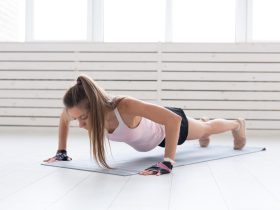The retro fitness trend of the ’90s, where people power-walked with weights strapped to their wrists, has made a comeback.
This time, it’s gaining popularity on social media platforms like TikTok, where users are incorporating wrist weights to enhance their walks and build muscle in their arms. Let’s see if it is worth adding this to your fitness routine.
Effectiveness of Walking with Wrist Weights
While walking has numerous benefits on its own, adding wrist weights to your walks introduces an extra load to your body, increasing the workout’s challenge and efficacy.
This added effort engages your muscles and joints more intensely and prompts your heart to pump faster, thereby strengthening your cardiac muscle. Incorporating wrist weights can thus make your daily walk more effective without needing to increase your pace.
A 2021 study published in the Federation of American Societies for Experimental Biology (FASEB) Journal found that wearing wrist weights while walking elevated heart rates and oxygen consumption, indicating a higher exercise intensity.
This suggests that wrist weights can enhance cardiovascular fitness by making the heart work harder to pump blood throughout the body.
Other research has shown that using wrist and ankle weights during daily activities for short periods can also contribute to increasing muscle mass. The additional resistance provided by wrist weights can stimulate muscle activity and endurance, helping to tone muscles over time.
However, it’s important to note that the muscle-building effects of wrist weights are minimal due to their relatively light load.
Significant muscle growth typically requires exercises that create microscopic tears in muscle fibers, which light wrist weights do not generally achieve. To build stronger biceps, triceps, and shoulders, it is essential to challenge these muscles with heavier weights.
Following a progressive overload plan, where you gradually increase the challenge by lifting heavier weights, adding more repetitions, or decreasing rest breaks, can help muscles continue to respond and grow.
Progressive overload is a principle in strength training that involves continuously increasing the demands on the musculoskeletal system to gain muscle mass and strength.
In summary, while wrist weights can enhance the intensity of your walks and provide cardiovascular benefits, they are not a substitute for heavier weightlifting required for significant muscle growth.
They are a useful tool for adding variety and intensity to workouts, particularly for those looking to boost their cardio and engage muscles more during walks. For those aiming for substantial muscle gains, incorporating a structured strength training program with progressively heavier weights is crucial.
5 Tips for Incorporating Wrist Weights into Your Walks
Before adding wrist weights to your walking routine, it’s important to consider several key points. If you have elbow or shoulder injuries, balance issues, or bone density concerns, consulting a doctor first is advisable.
For those cleared to use wrist weights, ensuring they do not disrupt your walking form is crucial.
- Start Gradually
Begin with wrist weights ranging from one to three pounds and gradually increase the weight as your body adapts. Avoid using weights heavier than five pounds to prevent excessive tension on your elbow joint.
It’s also wise to reduce your walking distance initially to allow your body to adjust to the added weight. Starting slowly helps prevent overuse injuries and ensures that your body can handle the additional load.
- Consider Rucking for a Cardio Boost
For those seeking an even greater cardio challenge, rucking – carrying extra weight on your trunk in a backpack or weighted vest – may be a better option.
This method allows you to add more weight without placing stress on your limbs, thereby intensifying your cardiovascular workout without impacting your arm muscles.
Rucking can be particularly effective for building endurance and strength in your lower body and core, offering a comprehensive workout that enhances overall fitness.
- Consulting a Professional
If you’re new to using wrist weights or unsure about how to incorporate them into your routine safely, consider consulting a fitness professional.
A personal trainer can provide guidance on proper form, appropriate weight selection, and integrating wrist weights into a comprehensive fitness program that aligns with your goals.
- Benefits and Risks
Using wrist weights can increase the intensity of your walking routine, helping to burn more calories and improve cardiovascular health. However, improper use can lead to joint strain or injury, particularly in the elbows and shoulders.
It’s crucial to use weights that are appropriate for your fitness level and to pay attention to any discomfort or pain. Listening to your body and adjusting your routine as needed will help you maximize benefits while minimizing risks.
- Maintain a Balanced Workout Routine
While wrist weights can enhance your walks, they should not be relied upon solely for building stronger arms. Incorporating upper-body strength training exercises into your fitness regimen is essential for significant muscle growth.
A well-rounded approach to fitness, including various types of workouts such as resistance training, cardio, flexibility exercises, and balance work, contributes to overall wellness.
Regularly engaging in strength training exercises like push-ups, bicep curls, and tricep dips will target and build muscle in your upper body more effectively than wrist weights alone.
In conclusion, wrist weights can add a fun and effective element to your fitness routine, increasing the intensity of your walks and providing cardiovascular benefits.
However, for substantial muscle growth, heavier weightlifting and a comprehensive workout plan are necessary.
Embrace this retro trend as a complementary part of your fitness journey, contributing to a diverse and robust wellness routine.
















Find Us on Socials